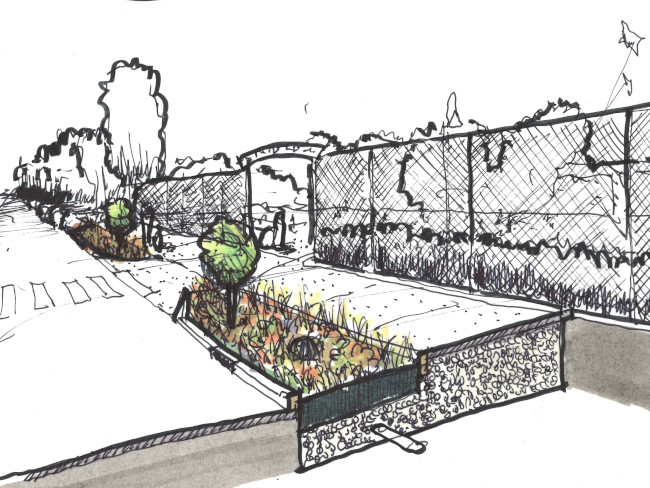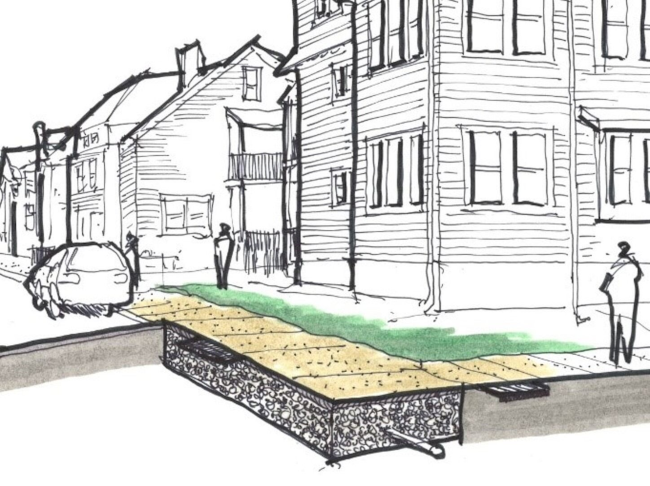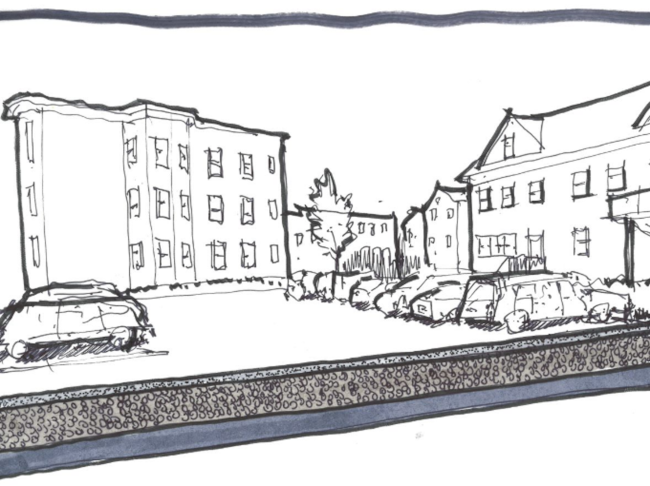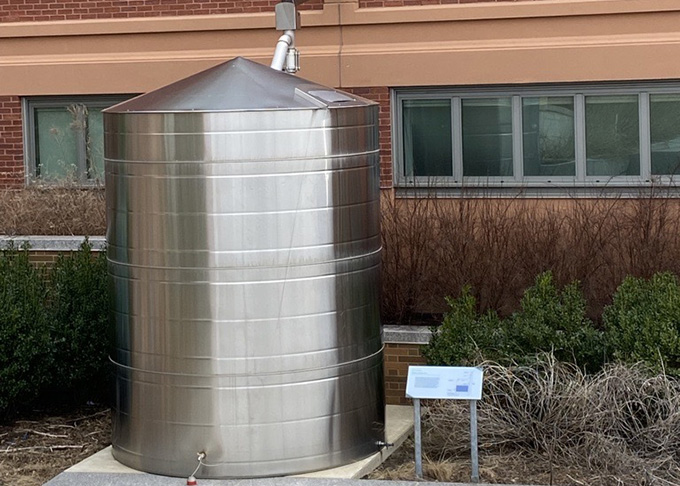Green Stormwater Infrastructure (GSI) systems help Somerville manage stormwater by mimicking the natural environment and processes. GSI uses natural materials, including soil, plants, and stone to reduce the amount of stormwater that enters the sewer system. This helps prevent pollutants from entering nearby waterways and keeps our environment healthy.
While GSI is an important part of our toolkit, it is just one of many ways we manage stormwater across Somerville. For a comprehensive look at how the City is working to improve and expand our drainage system’s capacity, visit our stormwater management page.
Jump To:
Managing stormwater runoff in dense, highly urban areas like Somerville, can be complex. Instead of only relying on traditional methods like pipes and concrete channels, we use an integrated approach to planning and design, incorporating Green Stormwater Infrastructure (GSI) systems where possible and effective.
To ensure that these GSI systems are working together with other improvements to our sewer system, we employ a range of flexible interventions: stormwater bump-outs, bioretention basins, subsurface infiltration trenches, porous and permeable pavements, etc. This maximizes the benefit of GSI interventions and helps us keep our environment clean and healthy. Read on to learn more about these GSI systems.

Stormwater Bump-outs /Rain Gardens (Click to expand section)
A landscaped curb extension or area which collects and filters stormwater.
What are stormwater bump-outs?
Stormwater bump-outs or rain gardens (sometimes known as bioretention basins) are landscaped areas designed to collect, treat, and temporarily store stormwater.
Subsurface storage can include soil, clean-washed stone, or a modular storage system.
How do they work?
- Stormwater runoff is directed to the surface of the system through curb cuts, trench drains, overland flow, or catch basins.
- Once collected, water slowly infiltrates through vegetation and engineered soils, providing water quality treatment and volume reduction. Where possible, the system is designed to allow the stored water to seep into the underlying soils. Where this is not possible, an underdrain is placed at the bottom of the system to capture and slowly release the collected stormwater runoff into the existing storm sewer.
- When stormwater runoff exceeds the capacity of the system, it can flow through the system to a downstream catch basin or could be piped to the existing storm sewer with an overflow structure within the system.

How do we decide where to install these systems?
Bump-outs are generally placed in a parking lane or roadway shoulder. Rain gardens can be installed in a variety of locations that experience stromwater runoff.
The City selects the best sites to install these systems based on a variety of factors, including street width, parking, bicycle lanes, bus routes, vehicular turning maneuvers, soil type, and subsurface utility conflicts.
Stormwater bump-outs in our City:
Stormwater bump-outs can be found along Somerville Avenue and are currently being built in the Spring Hill Neighborhood.


Subsurface Infiltration Trenches
Underground storage that collects and stores stormwater until it can infiltrate into the subsurface soil.
What are subsurface infiltration trenches?
Below-grade (or below ground level) stone storage systems designed to collect, treat, and temporarily store stormwater runoff. Stormwater runoff is directed to the system through a new catch basin placed directly upstream of an existing catch basin (to capture water prior to it entering the existing storm system).
Subsurface trenches can be located below any surface, including parking lots, pavement, or landscaped areas.
Subsurface storage can include clean, washed stone, piping and other storage units, or modular storage systems.
How do they work?
- Once inside the system, stormwater water is detained and either infiltrated or slowly released back into the existing storm sewer after the peak of the storm has passed. Where possible, the system is designed to allow the stored water to seep into the underlying soils. Where this is not possible, an underdrain is placed at the bottom of the system to capture and slowly-release the collected stormwater runoff into the existing storm sewer.
- When stormwater runoff exceeds the system’s capacity, it can bypass the system to a downstream catch basin.

What do we look at when deciding where to install these systems?
Site factors the City considers are the proximity to adjacent buildings and feasibility of infiltration to underlying soils. If infiltration is not possible, an engineered soil media can be used with the subsurface trench for water quality management before being released back into the existing storm sewer.
Subsurface Infiltration Trenches in our City:
Massive infiltration trenches were installed underneath the baseball and soccer fields at Lincoln Park, next to the Argenziano School, and at Conway Park. Smaller infiltration trenches have been installed along Somerville Avenue.


Porous and Permeable Pavement
Surfaces that provide the support of conventional paving but are porous and designed to collect and filter stormwater runoff.
What is porous and permeable pavement?
Paving systems that provide the structural support of conventional pavements but are designed to collect, treat, convey, and temporarily store stormwater runoff. Permeable pavements consist of a porous surface material over a bed of clean, washed stone. Permeable pavement comes in a variety of materials, including paver blocks, concrete, rubberized play surface, or asphalt.

What do we look at when deciding where to install these systems?
Porous and permeable pavements can be used in place of traditional pavement, usually for less trafficked areas such as walking/cycling paths and parking lots.
Porous and permeable pavement in our City:
Porous pavement has been installed as cycle tracks along Somerville Ave from Union Square to Medford Street. Permeable pavers have been installed in the parking lots of West Branch Library and in certain areas in from of the Somerville High School.


Rainwater Harvester
Storage systems that capture rainwater from roofs or other surface for later use.
What is a rainwater harvester?
Rainwater harvesters collect and store rain as it falls on roofs or other non-permeable surfaces. In addition to being diverted from the sewer systems, the water collected can be used for other purposes such as watering gardens and landscapes.
How do they work?
Gutters, pipes, and/or drainage grates direct rain water to a storage tank. This tank can be located above or below ground.
Stored water can then be direct to irrigation systems or other uses.

What do we look at when deciding where to install these systems?
Rainwater harvesting systems can be installed on large city-owned buildings whose roofs collect a high volume of stormwater or areas on non-permeable surface without other underlying utilities.
Nearby gardens or green space that could benefit for the water are also considered when choosing locations for rainwater harvester.
Rainwater harvesting in our City :
Somerville High School, the Argenziano School, and Symphony Park in East Somerville are all home to rainwater harvesting systems.

Somerville has studied how best to incorporate GSI within Somerville’s dense urban environment since 2019.
The City developed its Green Stormwater Infrastructure (GSI) planning framework based on this research. We use this framework in all infrastructure improvements, both at a strategic planning and project-specific level. It helps us ensure that we’re using the best possible methods to manage stormwater runoff and keep our environment healthy.
Use the interactive map below to see GSI installations around city.

Programs & Initiatives
Feedback
Please submit website feedback using this form. Be sure to include:
Thank you for your feedback!

